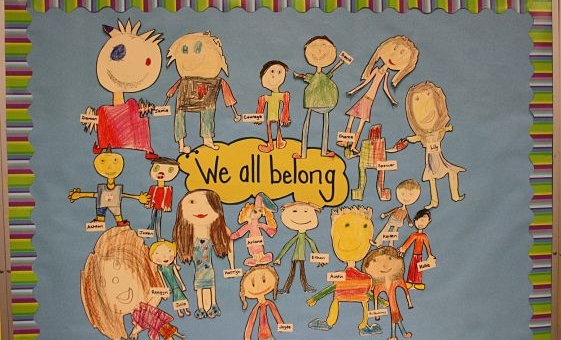Lead By Example
You as teacher, more than anyone else, can show the other students in your class that you expect them to include the students who have disabilities, and how they can do this. Below the story you will find several reminders.

“It’s going to be a great year!”
Belonging has always been a theme woven through my everyday interactions with students. I recall reading that Belonging flows from trust. As an educator, I focus on creating a trusting environment where all children can feel safe enough to share their strengths, interests and areas of growth with each other. Whatever our challenges, we all come to school to feel appreciated and to know our friends care about us. My students depend upon me to model this concept. This year I returned to a primary classroom in our school district after fifteen years as a Special Educator. I wanted to bring my joy about learning and delight in being with a classroom community to my new class. I wanted the kids to hear the word “Belonging,” understand its meaning, and experience its gift.
We started the year by drawing pictures of ourselves. We outlined the pictures, cut them out and posted them on a central bulletin board in the classroom with the caption, “We all Belong”. Later in the day, some friendship issues arose and we were able to work through the tears with gentle listening and compassionate problem solving. We looked at our “belonging board” and realized when we are not welcoming to all our classmates, it’s like one of the little people on the board falls off. I told the students that it was my hope for this year that they all feel like they belong. It was then that one of my students who I didn’t think was engaged in the discussion said, “Well Ms Mawhinney, if belonging is what you want for us, why is your drawing picture not included in the belonging board with ours?” I had not realized that I didn’t place myself with the group. He noticed I was missing! He noticed someone didn’t belong. It’s going to be a great year!
Bridget Mawhinney, Teacher, School District 71 (Comox Valley), British Columbia
Engage with students who have a disability directly when you speak to them, rather than speaking through their educational assistant. (You can include the EA with brief eye contact.)
Speak to them as you would their other classmates. If you talk to them as if they are different, other students will treat them as if they are different.
Give them the same assignments as their peers, but modified to their ability level.
Be inclusive in the way you set up classroom and small group seating.
Support the students who have a disability to participate actively in classroom activities and opportunities. Be creative. Find do-able tasks. Good preparation of educational assistants and peer leaders can help. It does not mean that every student will do the same thing, but every student can have a place and contribute.
Try to make interaction with the student who has a disability attractive to their classmates.
Set up one-on-one partnering so that students who wish to participate in more complex activities such as dance and drama can do so. Promote the recognition that such partnered participation can bring a new element of surprise and creativity to performances.
Enable opportunities for giving to others. Being able to give is a fundamental source of human dignity and a basic privilege of citizenship. Giving can take many forms - welcoming visitors, making cards for birthdays, helping in the preparation of refreshments. Thank students for their contribution.


